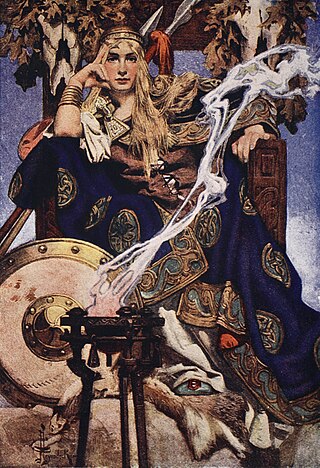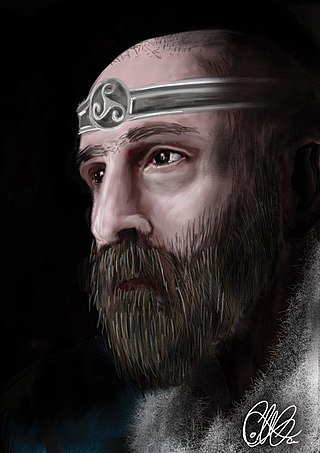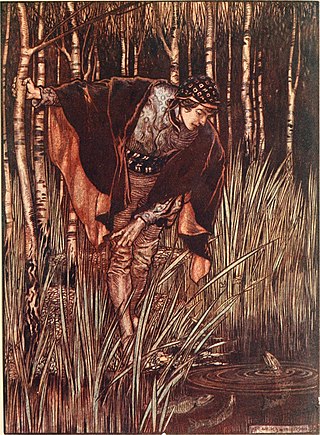Related Research Articles

Boann or Boand is the Irish goddess of the River Boyne (Bóinn), an important river in Ireland's historical province of Meath. According to the Lebor Gabála Érenn and Táin Bó Fraích she was the sister of Befind and daughter of Delbáeth, son of Elada, of the Tuatha Dé Danann. Her husband is variously Nechtan or Elcmar. With her lover the Dagda, she is the mother of Aengus.
Conall Cernach is a hero of the Ulaid in the Ulster Cycle of Irish mythology. He had a crooked neck and is said to have always slept with the head of a Connachtman under his knee. His epithet is normally translated as "victorious" or "triumphant", although it is an obscure word, and some texts struggle to explain it. Alternative meanings include "angular, having corners", "swollen", or "possessing a dish or receptacle". The original form of the name "Conall" in Ogham inscriptions was Cunavalas.

Medb, later spelled Meadhbh, Méabh(a) and Méibh, and often anglicised as Maeve, is queen of Connacht in the Ulster Cycle of Irish mythology. Her husband in the core stories of the cycle is Ailill mac Máta, although she had several husbands before him who were also kings of Connacht. She rules from Cruachan. She is the enemy of Conchobar mac Nessa, king of Ulster, and is best known for starting the Táin Bó Cúailnge to steal Ulster's prize stud bull Donn Cúailnge.

Ailill mac Máta is the king of the Connachta and the husband of queen Medb in the Ulster Cycle of Irish mythology. He rules from Cruachan.

Rathcroghan is a complex of archaeological sites near Tulsk in County Roscommon, Ireland. It is identified as the site of Cruachan, the traditional capital of the Connachta, the prehistoric and early historic rulers of the western territory. The Rathcroghan Complex is a unique archaeological landscape with many references found in early Irish medieval manuscripts.

Polycrates, son of Aeaces, was the tyrant of Samos from the 540s BC to 522 BC. He had a reputation as both a fierce warrior and an enlightened tyrant.
Fráech is a Connacht hero in the Ulster Cycle of Irish mythology. He is the nephew of Boann, goddess of the river Boyne, and son of Idath of the men of Connaught and Bébinn, and is renowned for his handsomeness and exploits. He belongs to the Fir Domnann.
Findabair or Finnabair was a daughter of Ailill and Queen Medb of Connacht in Irish mythology. The meaning of the name is "white phantom". The Dindsenchas also mention a Findabair who is the daughter of Lugaid Laigde.

Shakuntala is the wife of Dushyanta and the mother of Emperor Bharata. Her story is told in the Adi Parva, the first of eighteen parts of the ancient Indian epic Mahabharata, and dramatized by many writers, the most famous adaptation being Kalidasa's play Abhijñānaśākuntala.

Abhijñānaśākuntalam, also known as Shakuntala, The Recognition of Shakuntala, The Sign of Shakuntala, and many other variants, is a Sanskrit play by the ancient Indian poet Kālidāsa, dramatizing the story of Śakuntalā told in the epic Mahābhārata and regarded as the best of Kālidāsa's works. Its exact date is uncertain, but Kālidāsa is often placed in the 4th century CE.

"The Fisherman and His Wife" is a German fairy tale collected by the Brothers Grimm in 1812. The tale is of Aarne–Thompson type 555, about dissatisfaction and greed. It may be classified as an anti-fairy tale.

"The White Snake" is a German fairy tale collected by the Brothers Grimm and published in Grimm's Fairy Tales. It is of Aarne–Thompson type 673, and includes an episode of type 554.
"The Three Princesses of Whiteland" is a Norwegian fairy tale, collected by Norwegian writers Peter Christen Asbjørnsen and Jørgen Moe in their collection of folktales and legends Norske folkeeventyr (1879). Scottish poet and novelist Andrew Lang collected it his The Red Fairy Book (1890).
The Golden-Headed Fish is an Armenian fairy tale. It was first collected by ethnologue and clergyman Karekin Servantsians in Hamov-Hotov (1884) with the title ԱԼԹՈՒՆ ԲԱՇ ԲԱԼԸՂ.

The Sea-Maiden is a Scottish fairy tale collected by John Francis Campbell in Popular Tales of the West Highlands, listing his informant as John Mackenzie, fisherman, near Inverary. Joseph Jacobs included it in Celtic Fairy Tales.

The Knights of the Fish is a Spanish fairy tale collected by Fernán Caballero in Cuentos. Oraciones y Adivinas. Andrew Lang included it in The Brown Fairy Book. A translation was published in Golden Rod Fairy Book. Another version of the tale appears in A Book of Enchantments and Curses by Ruth Manning-Sanders.

Go I Know Not Whither and Fetch I Know Not What is a Russian fairy tale collected by Alexander Afanasyev in Narodnye russkie skazki.

Polycrates' Ring is a lyrical ballad written in June 1797 by Friedrich Schiller and first published in his 1798 Musen-Almanach annual. It is about how the greatest success gives reason to fear disaster. Schiller relied on the accounts of the fate of Polycrates, tyrant of Samos, in Herodotus' Histories, Book III.
Carnfree is a site south of the village of Tulsk in Roscommon that also lies close to the more celebrated ancient landscape of Rathcroghan. The chief feature here is the bronze-age mound of Carnfree itself, believed to be the cairn of the Connacht warrior Fráech, that was used as an inauguration place up to late medieval times. It also encompasses an area known as Selc featuring Duma Selga and the ecclesiastical site where Saint Patrick baptised the Ui Brian princes of Connacht, who according to the saint's biography may have resided in or administrated from this area.

Sakunthala is a 1966 Telugu-language Hindu mythological film directed by Kamalakara Kameswara Rao. The film stars N. T. Rama Rao and B. Saroja Devi, with music composed by Ghantasala. It is produced by Lakshmi Rajyam and Sridhar Rao under the Rajyam Productions banner.
References
- ↑ This trope, sometimes called a "bellerophontic letter", receives a classic version in the Greek myth of Bellerophon.
- 1 2 Stith Thompson, The Folktale, p 139, University of California Press, Berkeley Los Angeles London, 1977
- ↑ Jacobs, Joseph. "The Fish and the Ring". English Fairy Tales. Archived from the original on 4 March 2018.
- 1 2 'Popular Tales and Fictions: Their Migrations and Transformations' By W. a. Clouston, Published by Kessinger Publishing, 2003 ISBN 0-7661-7622-3, ISBN 978-0-7661-7622-5
- ↑ Ford, Patrick K (1992). Ystoria Taliesin. Cardiff: University of Wales. pp. 109–110. ISBN 978-0-7083-1092-2. OCLC 26803558.
- ↑ "The Oxford Cantigas de Santa Maria database | View poem data". csm.mml.ox.ac.uk. Retrieved 9 October 2020.